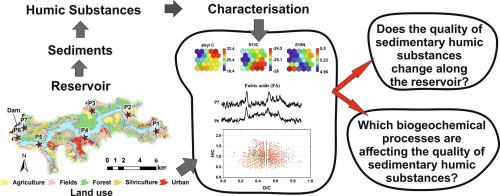当前位置:
X-MOL 学术
›
Org. Geochem.
›
论文详情
Our official English website, www.x-mol.net, welcomes your
feedback! (Note: you will need to create a separate account there.)
Multi-proxy approach involving ultrahigh resolution mass spectrometry and self-organising maps to investigate the origin and quality of sedimentary organic matter across a subtropical reservoir
Organic Geochemistry ( IF 2.6 ) Pub Date : 2021-01-01 , DOI: 10.1016/j.orggeochem.2020.104165 Erik Sartori Jeunon Gontijo , Peter Herzsprung , Oliver J. Lechtenfeld , Carolina de Castro Bueno , Johannes A.C. Barth , André H. Rosa , Kurt Friese
Organic Geochemistry ( IF 2.6 ) Pub Date : 2021-01-01 , DOI: 10.1016/j.orggeochem.2020.104165 Erik Sartori Jeunon Gontijo , Peter Herzsprung , Oliver J. Lechtenfeld , Carolina de Castro Bueno , Johannes A.C. Barth , André H. Rosa , Kurt Friese

|
Abstract Humic substances (HS) in sediments play an important role in carbon and nutrient biogeochemical cycles and fate of contaminants in the environment. However, information regarding HS quality and transformations that may affect their behaviour in reservoirs is still limited. The aim of this investigation was to track sources and changes in sedimentary HS across a subtropical reservoir, connecting them to in-lake processes and land-use influences. Surface sediments were collected at seven sampling sites in Itupararanga Reservoir (Brazil). Humic (HA) and fulvic (FA) acids (components of HS) were extracted from the sediment samples followed by in-depth characterisation via UV/VIS, fluorescence spectroscopy, elemental (C, N) and isotopic analysis (δ13C, δ15N), nuclear magnetic resonance (13C NMR) and Fourier-transform ion cyclotron resonance mass spectrometry (FT-ICR-MS). All data were analysed by self-organising maps. The results showed that samples from the upstream part of the reservoir were older and more decomposed. They likely originated from C3 land-plants (δ13C varied from −26.3‰ to −22.4‰), having more aromatic, oxygen-poor (O/C 0.5) and partly more unsaturated compounds for FA as well as oxygen-poor and saturated compounds with H/C > 1.1 for HA. Self-organising maps pointed out these differences between upstream and dam areas and indicated that agriculture lands were related to microbially-derived HS. Changes in HS composition revealed that internal reservoir processes may have influenced HS quality across the reservoir.
中文翻译:

涉及超高分辨率质谱和自组织图的多代理方法研究亚热带水库沉积有机质的来源和质量
摘要 沉积物中的腐殖质 (HS) 在碳和养分生物地球化学循环和环境中污染物的归宿中起着重要作用。然而,关于可能影响其在储层中行为的 HS 质量和转化的信息仍然有限。本次调查的目的是追踪亚热带水库中沉积 HS 的来源和变化,将它们与湖内过程和土地利用影响联系起来。在 Itupararanga 水库(巴西)的七个采样点收集了表层沉积物。从沉积物样品中提取腐殖酸 (HA) 和富里酸 (FA)(HS 的成分),然后通过 UV/VIS、荧光光谱、元素(C、N)和同位素分析(δ13C、δ15N)进行深入表征,核磁共振(13C NMR)和傅里叶变换离子回旋共振质谱(FT-ICR-MS)。所有数据均通过自组织图进行分析。结果表明,水库上游部分的样品年代较久,分解较多。它们可能起源于 C3 陆生植物(δ13C 从 -26.3‰ 到 -22.4‰),具有更多芳香族、贫氧 (O/C 0.5) 和部分更多的 FA 不饱和化合物以及贫氧和饱和化合物对于 HA,H/C > 1.1。自组织地图指出了上游和大坝区域之间的这些差异,并表明农业用地与微生物来源的 H2S 相关。HS 组成的变化表明,内部储层过程可能影响了整个储层的 HS 质量。所有数据均通过自组织图进行分析。结果表明,来自水库上游部分的样品年龄更大,分解程度更高。它们可能起源于 C3 陆生植物(δ13C 从 -26.3‰ 到 -22.4‰),具有更多芳香族、贫氧 (O/C 0.5) 和部分更多的 FA 不饱和化合物以及贫氧和饱和化合物对于 HA,H/C > 1.1。自组织地图指出了上游和大坝区域之间的这些差异,并表明农业用地与微生物来源的 H2S 相关。HS 组成的变化表明,内部储层过程可能影响了整个储层的 HS 质量。所有数据均通过自组织图进行分析。结果表明,水库上游部分的样品年代较久,分解较多。它们可能起源于 C3 陆生植物(δ13C 从 -26.3‰ 到 -22.4‰),具有更多芳香族、贫氧 (O/C 0.5) 和部分更多的 FA 不饱和化合物以及贫氧和饱和化合物对于 HA,H/C > 1.1。自组织地图指出了上游和大坝区域之间的这些差异,并表明农业用地与微生物来源的 H2S 相关。HS 组成的变化表明,内部储层过程可能影响了整个储层的 HS 质量。4‰),对于 FA 具有更多的芳香族、贫氧 (O/C 0.5) 和部分更多的不饱和化合物以及对于 HA 具有 H/C > 1.1 的贫氧和饱和化合物。自组织地图指出了上游和大坝区域之间的这些差异,并表明农业用地与微生物来源的 H2S 相关。HS 组成的变化表明,内部储层过程可能影响了整个储层的 HS 质量。4‰),对于 FA 具有更多的芳香族、贫氧 (O/C 0.5) 和部分更多的不饱和化合物以及对于 HA 具有 H/C > 1.1 的贫氧和饱和化合物。自组织地图指出了上游和大坝区域之间的这些差异,并表明农业用地与微生物来源的 H2S 相关。HS 组成的变化表明,内部储层过程可能影响了整个储层的 HS 质量。
更新日期:2021-01-01
中文翻译:

涉及超高分辨率质谱和自组织图的多代理方法研究亚热带水库沉积有机质的来源和质量
摘要 沉积物中的腐殖质 (HS) 在碳和养分生物地球化学循环和环境中污染物的归宿中起着重要作用。然而,关于可能影响其在储层中行为的 HS 质量和转化的信息仍然有限。本次调查的目的是追踪亚热带水库中沉积 HS 的来源和变化,将它们与湖内过程和土地利用影响联系起来。在 Itupararanga 水库(巴西)的七个采样点收集了表层沉积物。从沉积物样品中提取腐殖酸 (HA) 和富里酸 (FA)(HS 的成分),然后通过 UV/VIS、荧光光谱、元素(C、N)和同位素分析(δ13C、δ15N)进行深入表征,核磁共振(13C NMR)和傅里叶变换离子回旋共振质谱(FT-ICR-MS)。所有数据均通过自组织图进行分析。结果表明,水库上游部分的样品年代较久,分解较多。它们可能起源于 C3 陆生植物(δ13C 从 -26.3‰ 到 -22.4‰),具有更多芳香族、贫氧 (O/C 0.5) 和部分更多的 FA 不饱和化合物以及贫氧和饱和化合物对于 HA,H/C > 1.1。自组织地图指出了上游和大坝区域之间的这些差异,并表明农业用地与微生物来源的 H2S 相关。HS 组成的变化表明,内部储层过程可能影响了整个储层的 HS 质量。所有数据均通过自组织图进行分析。结果表明,来自水库上游部分的样品年龄更大,分解程度更高。它们可能起源于 C3 陆生植物(δ13C 从 -26.3‰ 到 -22.4‰),具有更多芳香族、贫氧 (O/C 0.5) 和部分更多的 FA 不饱和化合物以及贫氧和饱和化合物对于 HA,H/C > 1.1。自组织地图指出了上游和大坝区域之间的这些差异,并表明农业用地与微生物来源的 H2S 相关。HS 组成的变化表明,内部储层过程可能影响了整个储层的 HS 质量。所有数据均通过自组织图进行分析。结果表明,水库上游部分的样品年代较久,分解较多。它们可能起源于 C3 陆生植物(δ13C 从 -26.3‰ 到 -22.4‰),具有更多芳香族、贫氧 (O/C 0.5) 和部分更多的 FA 不饱和化合物以及贫氧和饱和化合物对于 HA,H/C > 1.1。自组织地图指出了上游和大坝区域之间的这些差异,并表明农业用地与微生物来源的 H2S 相关。HS 组成的变化表明,内部储层过程可能影响了整个储层的 HS 质量。4‰),对于 FA 具有更多的芳香族、贫氧 (O/C 0.5) 和部分更多的不饱和化合物以及对于 HA 具有 H/C > 1.1 的贫氧和饱和化合物。自组织地图指出了上游和大坝区域之间的这些差异,并表明农业用地与微生物来源的 H2S 相关。HS 组成的变化表明,内部储层过程可能影响了整个储层的 HS 质量。4‰),对于 FA 具有更多的芳香族、贫氧 (O/C 0.5) 和部分更多的不饱和化合物以及对于 HA 具有 H/C > 1.1 的贫氧和饱和化合物。自组织地图指出了上游和大坝区域之间的这些差异,并表明农业用地与微生物来源的 H2S 相关。HS 组成的变化表明,内部储层过程可能影响了整个储层的 HS 质量。











































 京公网安备 11010802027423号
京公网安备 11010802027423号